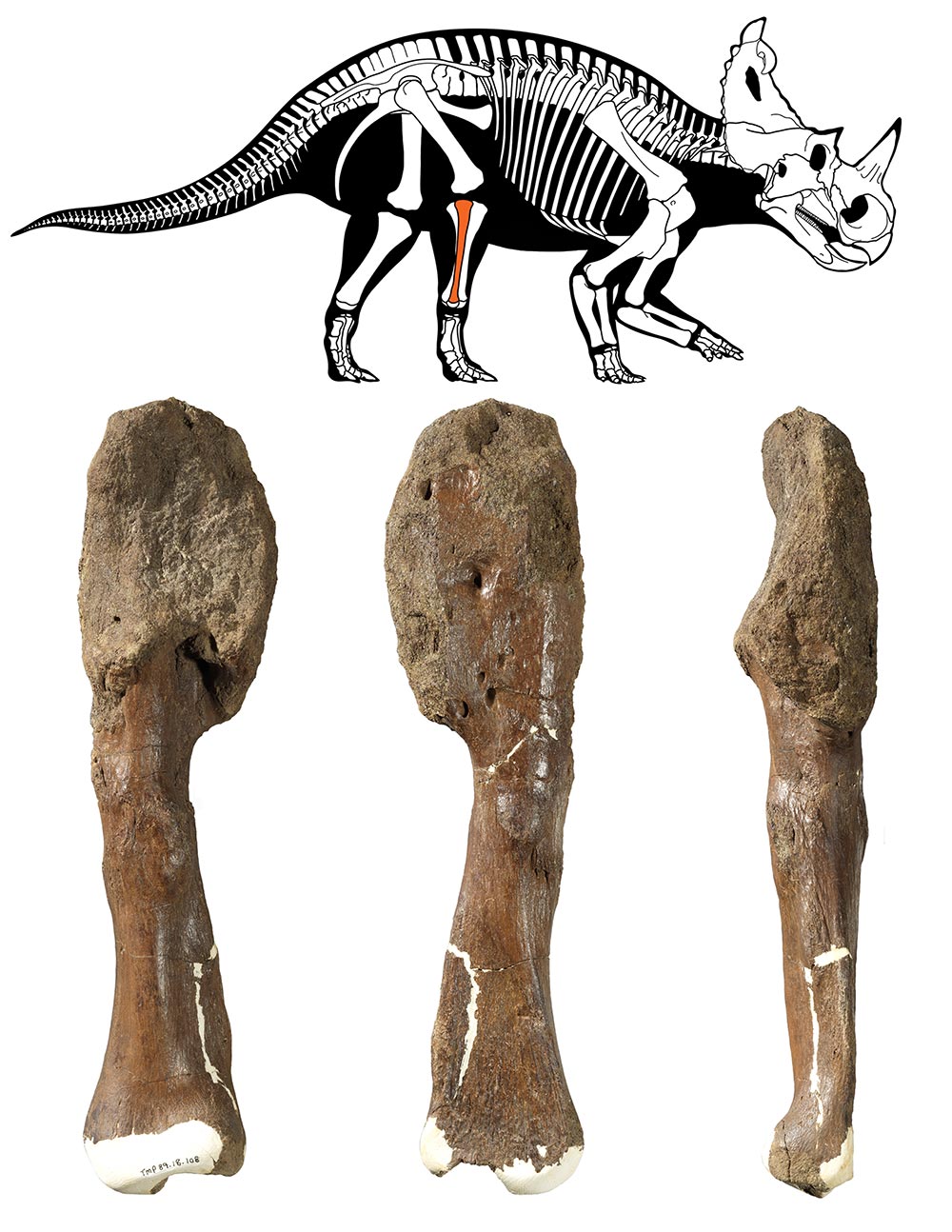最新研究证实:恐龙也会得癌症
一个加拿大研究团队称,他们将史前化石分析技术与现代人类医学诊断方法相结合,发现了恐龙患恶性肿瘤的第一个明确病例。
这篇论文周一发表于医学期刊《柳叶刀肿瘤学》(The Lancet Oncology),主要研究人员来自多伦多的皇家安大略博物馆(Royal Ontario Museum,ROM)和位于安大略省哈密尔顿的麦克马斯特大学(McMaster University)。研究人员表示,这个病例表明包括骨癌在内的恶性肿瘤“在生物体进化史中早已存在。”
研究人员研究了尖角龙的一段小腿骨。这种角龙科恐龙生活在距今约7,600万至7,700万年前。这块腿骨于1989年出土于加拿大艾伯塔省南部省立恐龙公园(Dinosaur Provincial Park)的一片荒地。该省立恐龙公园是联合国教科文组织(UNESCO)评定的世界自然遗产,也是世界上恐龙化石最多的地区之一。
2017年,在艾伯塔省皇家蒂勒尔博物馆(Royal Tyrrell Museum)展出的这块变形的腿骨,引起了前来参观的研究人员的注意。研究恐龙和人体病理学的专家组成了研究团队,其中还包括整形外科医生。
研究人员检查了这块腿骨,制作了模型,进行了高分辨率CT扫描,将骨头切成了极薄的截面,并进行了细胞检查以跟踪癌细胞在骨头中的进展情况,最终诊断这只恐龙患有骨肉瘤。研究人员将这块腿骨与同类恐龙的正常腓骨,以及确诊患有同类癌症的人类骨头进行了对比。

尖角龙属恐龙示意图由Danielle Dufault提供图片由皇家安大略博物馆/麦克马斯特大学提供。
骨肉瘤是人类最常见的骨癌,常见于青少年人群,包括加拿大长跑运动员特里·福克斯。
研究人员在论文中指出,以前很难在恐龙化石中找到癌症的证据,不仅是因为骨头变成化石之后软组织已经消失,还因为在变成化石的过程中,骨头本身往往会遭到破坏。他们进一步表示,恐龙骨化石的稀有性和独特性也使研究人员不愿意为了进行化验而破坏它们。
麦克马斯特大学病理学与分子医学教授马克·克劳瑟博士表示:“在恐龙体内诊断这种浸润性癌症一直无法成功,这需要医学专业知识,并进行不同层面的分析后才能做出准确判定。
在这次研究中,我们从7,600万年前的角龙科恐龙身上准确无误地找到了晚期骨癌的特征,这是第一次。这个发现令人激动不已。”马克·克劳瑟博士是皇家安大略博物馆的志愿者,自称是一位恐龙爱好者。
皇家安大略博物馆的古生物学家戴维·埃文斯博士表示,这只恐龙所患的是浸润性癌症,并且处在晚期,“这可能让这只恐龙行动不便,很容易沦为强大的肉食性恐龙的猎物。”
他怀疑这只大型食草类尖角龙之所以能够存活更长时间,可能是得益于庞大族群的保护,否则正常情况下患上这种疾病之后,它很难长时间存活下去。
研究人员最后得出的结论是,这只恐龙可能并非死于癌症或霸王龙。
相反,这只恐龙被发现的地方是一处庞大的骨床,还有其他化石,这表明这只恐龙及其庞大的族群死于另外一种长期存在的威胁:洪水。(财富中文网)
翻译:刘进龙
审校:汪皓
一个加拿大研究团队称,他们将史前化石分析技术与现代人类医学诊断方法相结合,发现了恐龙患恶性肿瘤的第一个明确病例。
这篇论文周一发表于医学期刊《柳叶刀肿瘤学》(The Lancet Oncology),主要研究人员来自多伦多的皇家安大略博物馆(Royal Ontario Museum,ROM)和位于安大略省哈密尔顿的麦克马斯特大学(McMaster University)。研究人员表示,这个病例表明包括骨癌在内的恶性肿瘤“在生物体进化史中早已存在。”
研究人员研究了尖角龙的一段小腿骨。这种角龙科恐龙生活在距今约7,600万至7,700万年前。这块腿骨于1989年出土于加拿大艾伯塔省南部省立恐龙公园(Dinosaur Provincial Park)的一片荒地。该省立恐龙公园是联合国教科文组织(UNESCO)评定的世界自然遗产,也是世界上恐龙化石最多的地区之一。
2017年,在艾伯塔省皇家蒂勒尔博物馆(Royal Tyrrell Museum)展出的这块变形的腿骨,引起了前来参观的研究人员的注意。研究恐龙和人体病理学的专家组成了研究团队,其中还包括整形外科医生。
研究人员检查了这块腿骨,制作了模型,进行了高分辨率CT扫描,将骨头切成了极薄的截面,并进行了细胞检查以跟踪癌细胞在骨头中的进展情况,最终诊断这只恐龙患有骨肉瘤。研究人员将这块腿骨与同类恐龙的正常腓骨,以及确诊患有同类癌症的人类骨头进行了对比。
骨肉瘤是人类最常见的骨癌,常见于青少年人群,包括加拿大长跑运动员特里·福克斯。
研究人员在论文中指出,以前很难在恐龙化石中找到癌症的证据,不仅是因为骨头变成化石之后软组织已经消失,还因为在变成化石的过程中,骨头本身往往会遭到破坏。他们进一步表示,恐龙骨化石的稀有性和独特性也使研究人员不愿意为了进行化验而破坏它们。
麦克马斯特大学病理学与分子医学教授马克·克劳瑟博士表示:“在恐龙体内诊断这种浸润性癌症一直无法成功,这需要医学专业知识,并进行不同层面的分析后才能做出准确判定。
在这次研究中,我们从7,600万年前的角龙科恐龙身上准确无误地找到了晚期骨癌的特征,这是第一次。这个发现令人激动不已。”马克·克劳瑟博士是皇家安大略博物馆的志愿者,自称是一位恐龙爱好者。
皇家安大略博物馆的古生物学家戴维·埃文斯博士表示,这只恐龙所患的是浸润性癌症,并且处在晚期,“这可能让这只恐龙行动不便,很容易沦为强大的肉食性恐龙的猎物。”
他怀疑这只大型食草类尖角龙之所以能够存活更长时间,可能是得益于庞大族群的保护,否则正常情况下患上这种疾病之后,它很难长时间存活下去。
研究人员最后得出的结论是,这只恐龙可能并非死于癌症或霸王龙。
相反,这只恐龙被发现的地方是一处庞大的骨床,还有其他化石,这表明这只恐龙及其庞大的族群死于另外一种长期存在的威胁:洪水。(财富中文网)
翻译:刘进龙
审校:汪皓
A group of Canadian researchers say they have discovered the first confirmed case of a dinosaur with malignant cancer—by combining the skills used to analyze prehistoric fossils with modern methods used to diagnose humans.
In a study published Monday in the medical journal The Lancet Oncology, researchers led by Toronto's Royal Ontario Museum (ROM) and McMaster University in Hamilton, Ontario, said the case suggested that malignant tumors, including bone cancers, "are rooted quite deeply in the evolutionary history of organisms."
The researchers examined a lower leg bone from centrosaurus apertus, a horned dinosaur that lived 76 to 77 million years ago. The bone itself was originally discovered in 1989 in the badlands of Dinosaur Provincial Park in southern Alberta, Canada, a UNESCO world heritage site and one of the most dinosaur fossil-rich regions in the world.
The bone, which was visibly malformed, caught the eye of researchers on a trip to Alberta's Royal Tyrrell Museum in 2017. A team of experts across both dinosaur and human pathology was assembled, including orthopedic surgeons.
The researchers examined and cast the bone, performed high-resolution CT scans, and sliced the bone into extremely thin sections, examining it at a cellular level to track the progression of the cancer into the bone, before diagnosing the dinosaur with osteosarcoma. The bone was then compared to a regular fibula bone from the same species of dinosaur, and a human bone with a confirmed case of the same cancer.
Osteosarcoma is the most common form of bone cancer in humans, and is usually found in teenagers and young adults, including the Canadian runner Terry Fox.
In the paper, researchers noted that it has previously been difficult to establish evidence of cancer in dinosaur fossils, not only because soft tissue is lost as the bones fossilize, but because the bones are often damaged in the process. The rarity and uniqueness of dinosaur bones has also made researchers reluctant to destroy them in order to conduct tests, they added.
"Diagnosis of aggressive cancer like this in dinosaurs has been elusive and requires medical expertise and multiple levels of analysis to properly identify," said Dr. Mark Crowther, a professor of pathology and molecular medicine at McMaster University, who is also an avowed fan of dinosaurs and a volunteer at the ROM.
"Here, we show the unmistakable signature of advanced bone cancer in a 76 million-year-old horned dinosaur—the first of its kind. It's very exciting."
The dinosaur's cancer was both aggressive and advanced, said Dr. David Evans, a paleontologist at the ROM, and "would have had crippling effects on the individual and made it very vulnerable to the formidable tyrannosaur predators of the time."
He speculated that the large, plant-eating centrosaurus apertus may have been protected by its place in a large, protective herd, allowing it to survive much longer than it normally would have with such a disease.
In the end, researchers concluded that it was unlikely the cancer—or a tyrannosaurus—actually killed the dinosaur.
Instead, its discovery in a massive bone bed alongside other fossils suggested the dino was killed alongside a large herd by another persistent danger: a flood.













